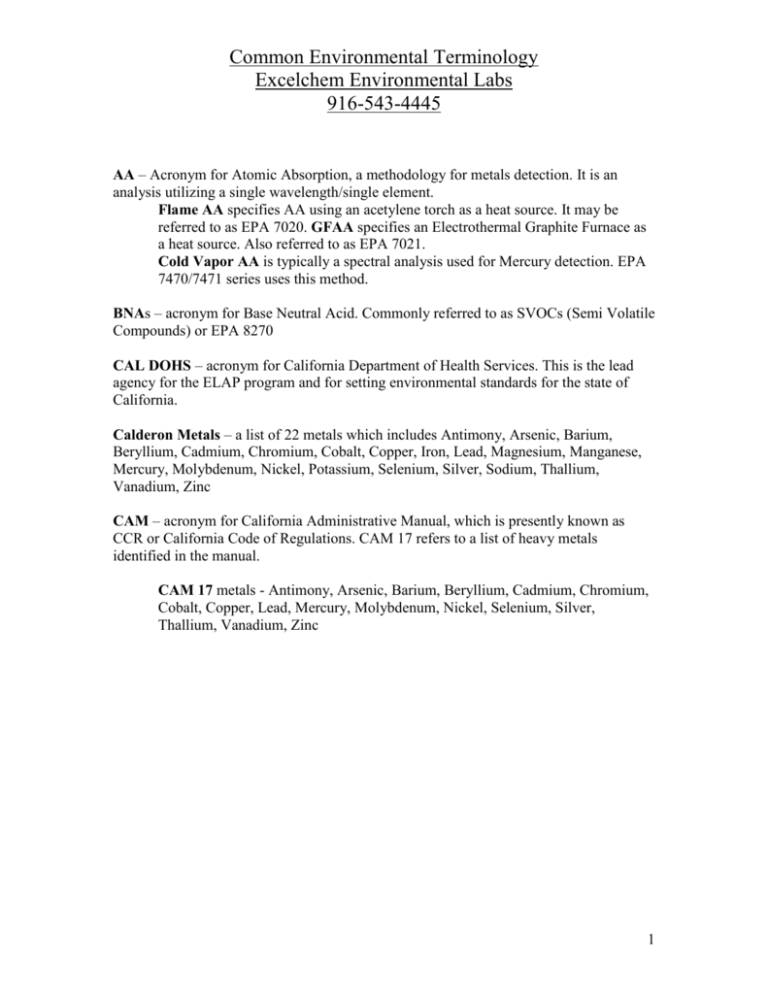Some common terminology used in Environmental
advertisement

Common Environmental Terminology Excelchem Environmental Labs 916-543-4445 AA – Acronym for Atomic Absorption, a methodology for metals detection. It is an analysis utilizing a single wavelength/single element. Flame AA specifies AA using an acetylene torch as a heat source. It may be referred to as EPA 7020. GFAA specifies an Electrothermal Graphite Furnace as a heat source. Also referred to as EPA 7021. Cold Vapor AA is typically a spectral analysis used for Mercury detection. EPA 7470/7471 series uses this method. BNAs – acronym for Base Neutral Acid. Commonly referred to as SVOCs (Semi Volatile Compounds) or EPA 8270 CAL DOHS – acronym for California Department of Health Services. This is the lead agency for the ELAP program and for setting environmental standards for the state of California. Calderon Metals – a list of 22 metals which includes Antimony, Arsenic, Barium, Beryllium, Cadmium, Chromium, Cobalt, Copper, Iron, Lead, Magnesium, Manganese, Mercury, Molybdenum, Nickel, Potassium, Selenium, Silver, Sodium, Thallium, Vanadium, Zinc CAM – acronym for California Administrative Manual, which is presently known as CCR or California Code of Regulations. CAM 17 refers to a list of heavy metals identified in the manual. CAM 17 metals - Antimony, Arsenic, Barium, Beryllium, Cadmium, Chromium, Cobalt, Copper, Lead, Mercury, Molybdenum, Nickel, Selenium, Silver, Thallium, Vanadium, Zinc 1 Common Environmental Terminology Excelchem Environmental Labs 916-543-4445 Carbon Range – refers to the amount of petroleum hydrocarbons found in a specific section of a chromatogram based on the retention time of pure alkanes such as hexane, heptane, octane, etc. (i.e. C6-C7, C8-C9, C10-C11, etc.) Pure straight chain hydrocarbons (alkanes) have retention times that increase regularly with the number of carbon atoms. These retention times are used to divide a chromatogram into carbon ranges: C8-C10 indicates that we are talking about the part of a chromatogram between the retention time of Octane (eight carbon atoms) and Decane (ten carbon atoms). The TPH of a Carbon Range is defined as the area of a range of the sample compared with the area of the same range of a reference standard. Carbon Ranges of some typical products: C4-C12 C4-C16 C9-C16 C9-C20 C11-C20 C12-C32 C18-C40/C50 C4-C40/C50 Gasoline Jet Fuel JP-4 Kerosene, Fuel Oil No 1 Diesel No 2 Fuel Oil No 2 Fuel Oil No 6, Bunker Oil Motor Oil Crude Oil CCR – Acronym for California Code of Regulations, also known as CAM (California Administrative Manual. CCR Title 22 refers to a list of heavy metals described in the California Code of Regulations or California Administrative Manual. Also referred to as CAM 17 metals. Chlorinated Hydrocarbons – refers to the list of Volatiles Organic Compounds (VOCs) contained in EPA 8010 and EPA 601. Also known as Chlorinated solvents or Purgeable Halocarbons. Digestion – The sample preparation method where the sample matrix is broken down with acids. Generally used for metals. DVBE - acronym for Disabled veteran-owned Business Enterprise. Used to denote a business that is majority owned and managed by a disabled veteran. Certain government contracts require a percentage set aside to guarantee participation of disadvantaged businesses. ELAP – acronym for Environmental Laboratory Accreditation Program. ELAP is responsible for the certification of environmental Laboratories in the state of California. Excelchem’s ELAP number is 2119. 2 Common Environmental Terminology Excelchem Environmental Labs 916-543-4445 EPA 8260 – EPA method for identification of a specified list of Volatile Organic Compounds (VOCs) using GC/MS EPA 8270 – EPA method for identification of a specified list of Semi Volatile Organic Compounds (SVOCs) using GC/MS Extraction – a sample preparation method where the analytes are extracted from the matrix. Generally used for organic compounds. GC/MS – acronym for Gas Chromatography/Mass Spectrometry. It refers to methods for identifying compounds with a Gas chromatograph to separate compounds and a Mass Spectrometer as a detector. IC – Acronym for Ion Chromatography, a method which can be used for the identification of Phosphate (PO4), Sulfate (SO4), Chloride (Cl), Fluoride (Fl), Bromide (Br), Nitrite (NO2), and Nitrate (NO3). ICP/MS – acronym for Inductively Coupled Plasma/Mass Spectrometry. Refers to methods for the detection of metals using an ICP as an Ion Source and a Mass Spec. as a detector. Used in EPA 6020. Leachable – describes the ability of toxic materials to be extracted from the soil be water in a natural environment. LUFT – acronym for Leaking Underground Fuel Tanks. Regulations for treatment of such tanks, including required analytical testing are laid out in federal and state programs, LUFT 5 heavy Metals – Cadmium (Cd), Chromium (Cr), Nickel (Ni), Lead (Pb), and Zinc (Zn) MBE – Acronym for Minority Owned Business Enterprise. It refers to a business that is majority owned and managed by a designated minority. Certain government contracts require a percentage set aside to guarantee participation of disadvantaged businesses. MTBE – acronym for Methyl Tert Butyl Ether. An oxygenate added to reformulated gasoline that lowers tailpipe emissions of Carbon Monoxide and VOCs. mg/Kg – abbreviation for milligrams per kilogram. It is a unit of measure used in analytical results, which expresses the concentration of the analyte. For example – 10 mg/kg MTBE. Normally used for solid or soil samples. mg/L – abbreviation for milligrams per liter. It is a unit of measure used in analytical results, which expresses the concentration of the analyte. For example – 15 mg/L lead. Normally used for STLC or TCLP analyses, which show the quantities of the analyte, which are Leachable. 3 Common Environmental Terminology Excelchem Environmental Labs 916-543-4445 PPB – abbreviation for parts per billion. It is a unit of measure used in analytical results, which expresses the concentration of the analyte. For example – 500 ppb Diesel. Normally used for liquid or aqueous samples. 1ppb = 1ug/L PPM – abbreviation for parts per million. It is a unit of measure used in analytical results, which expresses the concentration of the analyte. For example – 10 ppm lead Normally used for solid or soil samples. 1ppm = 1mg/kg PPT - abbreviation for parts per trillion. It is a unit of measure used in analytical results, which expresses the concentration of the analyte. For example – 5 ppt gasoline Normally used for air or vapor samples. Priority Pollutant Metals – a list of 13 metals including Antimony, Arsenic, Beryllium, Cadmium, Chromium, Copper, Lead, Mercury, Nickel, Selenium, Silver, Thallium, and Zinc Priority Pollutants – the list of VOCs contained in EPA 8240 QC samples – Quality Control samples. Common QC samples are Blank – A lab grade quantity of the sample matrix is prepared and analyzed along with the samples to ensure no contaminants are being introduced. LCS/LCSD – Laboratory Control Sample/Laboratory Control Sample Duplicate. Two clean quantities of the sample matrix are spiked with a known amount of analyte. These are analyzed along with the samples to ensure that the methods are accurate. MS/MSD – Matrix Spike/matrix Spike duplicate. Two replicates of a sample are spiked with a known amount of analyte. These are analyzed along with the samples to ensure that the methods are accurate. SBE – acronym for Small Business Enterprise. It denotes a business of limited size. Certain government contracts require a percentage set aside to guarantee participation of disadvantaged businesses. Excelchem’s small business certificate number is 0004700 SIM – acronym for Selected ion monitoring. SIM sets the mass selective detector to repeatedly scan a few selected ions rather than a full spectrum. In the acquisition method (GC/MS SIM) the selected ions can be changed to reflect the desired compound to be detected. The detector scans for a primary, secondary, and tertiary ion set unique to the compound of interest in a particular retention time window. Soluble – used in the characterization of metals as hazardous waste. It is often used interchangeable with “WET” or “STLC” when referring to the amount of a metal that is Leachable i.e. soluble lead. The extraction process takes 48 hours. 4 Common Environmental Terminology Excelchem Environmental Labs 916-543-4445 SVOCs – Acronym for Semi Volatile Organic Compounds. Also referred to as BNAs or EPA 8270 TCLP – acronym for Toxicity Characteristic Leachate Procedure and is used to characterize the mobility of both organic and inorganic analytes present in liquid and solid wastes. It is an extraction method prescribed by CFR (Code of Federal Regulations). The extraction process takes 18 hours. TDS – acronym for Total Dissolved solids. Sometimes referred to as filterable residue. TPH – acronym for total Petroleum Hydrocarbons. It is the measure of the total amount of fuel present in the sample. TPH results can be quantified or calculated as: Totals as specific fuel types (TPH as Diesel, TPH as Gasoline) Totals in specific carbon ranges (C10-C25) TSS – acronym for Total Suspended Solids. Sometimes referred to as non-filterable residue. TTLC – acronym for Total Threshold Limit Concentration and is mainly used in quantification of metals. It is often used interchangeably with “total” – for example TTLC or total Lead. In correct scientific terms, TTLC refers to the soil concentration limits as defined in CCR title 22. g/L – abbreviation for micrograms per liter. It is a unit of measure used in analytical results, which expresses the concentration of the analyte. For example – 10g/L Benzene. Normally used for liquid or aqueous samples VOAs – acronym for Volatile Organic Analysis (or Analytes). This acronym is rarely used as it has been replaced by the term VOCs.. VOA Vial – a sampling container holding approximately 42 milliliters of fluid. These are used for collecting water samples primarily for VOCs. Cars should be used when sampling to ensure no headspace is resent in the VOA vial. VOCs – Volatile Organic Compounds. Generally refers to the list of compounds contained in EPA 8240 or EPA 8260. WBE – acronym for Woman Owned Business. It denotes a business that is majority owned and managed by a woman. Certain government contracts require a percentage set aside to guarantee participation of disadvantaged businesses. 5 Common Environmental Terminology Excelchem Environmental Labs 916-543-4445 WET – acronym for Waste Extraction Test and is used in the characterization of metals as hazardous waste. It is often used interchangeably with “STLC” or “soluble” when referring to the amount of a metal that is leachable. The extraction process take 48 hours and can be done as either an WET-STLC using a citrate acid buffer solution or as a WET-DI using DI water. ZHE – acronym for Zero Headspace Extraction. This is the TCLP method for VOCs as defined by the CFR. The extraction process takes 18 hours. 6






